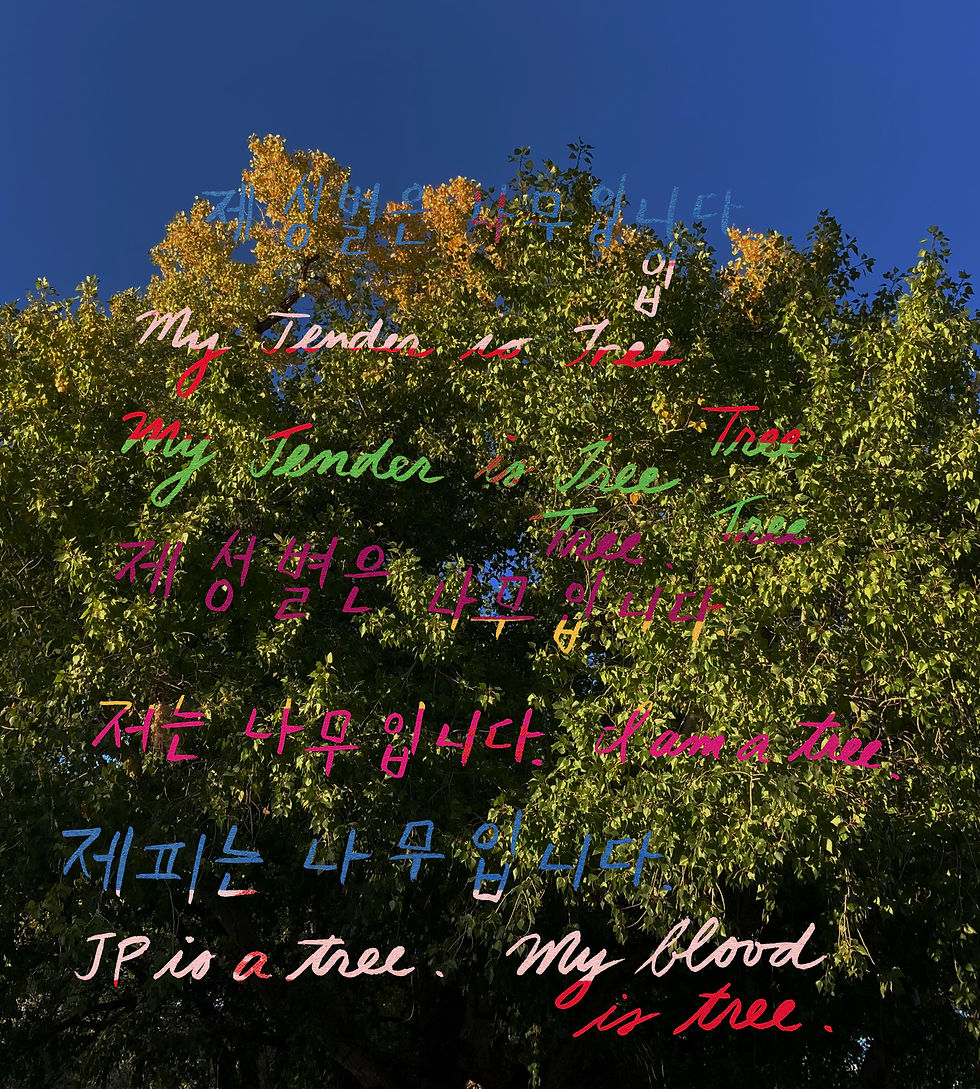My Jender is Tree
- J P 제피
- Sep 29, 2022
- 3 min read
Updated: Nov 21, 2022

I explore the relationship between truth, beauty, and identity in my artwork. More recently, language and story are main characters alongside symbol and abstraction. Something massive is shifting, integrating… I hope to achieve alchemy. Sometimes these intersections are so vast and broad and my pace is very slow. It is slow because I am a tree.
Early this year I began naming privately that my gender is tree. More accurately, my Jender is tree. Trees are, more often than not, cosexual or monoecious. This means that an individual tree has male and female blooms. I am in spiritual relationship with a community of cottonwood trees on the acequias near my home (which are, incidentally, dioecious). They’ve taught me so much, including reminding me that my shape and pace as a tree is an honoring of the Shape of Me: a person who is bigender and bicultural and a site of integration.

The phonetic spelling of ‘J P’ in Hangul is 제피. 제 means ‘my’ in Korean and 피 means ‘blood’. Every time you say my true name - J P 제피 - you acknowledge that I am of your blood. You acknowledge me in relationship to you as your relative. You acknowledge that we are kin.
J P is a tree.
제피는 나무입니다.
My blood is tree.
Because my blood is tree, you in your human form are also related to trees. This is the vast Shape of We that transcends species, form, time, matter. We are infinite.
This is what the trees have taught me. I am beginning to sense that queer, transgender, multicultural people are the link to something much bigger than we can imagine - our liberation is not just gender and race. It is inter-species between plant, animal, human, natural form, spirit, cosmos. It is bigger than we can possibly know.
I rediscovered this image of me at age 23 and added the seakdong mountains, danchong blossoms, tree image, and Hangul and English text.

It is the younger me, reaching to be my tree self in queerness long before I was able to name myself as queer. S(he) could access self only through artifice. (He)r spiky hair is dyed an aggressive red, (he)r neck is adorned with plastic flowers, and the backdrop is made of faux leaves. A friend described this image as glam and distant. I have only compassion for this younger version of J P 제피, who could not quite access (he)r tree self. It was not safe to Be and s(he) worked hard to survive in an environment that was / is unsafe and hostile to Asian female bodied people. S(he) was being raped in relationship in a ritual re-creation of the bodily threat s(he) witnessed / experienced growing up in an unsafe home. S(he) wasn’t able to take on queerness too.
It was a home unsafe to be a girl / and
the boy spirit tucked away protected (he)r girl body from immediate harm / and
not safe to be the boy-girl s(he) was / and
hostility to the maleness in female body: everywhere, everywhere (stay tucked, stay small) / then
the harm absorbed in female body spills into rivers of future self /
cuts into me flesh, flesh that can bleed, and trees call in time of deepest need.
Remember us. Remember me. We are we. You can Be.
Old habit to tuck away male erupts into J P 제피 /
my blood.
My blood is tree.
My blood bleeds tree.
A friend encouraged me to recreate the photo of 23 year old J P 제피. This is interesting. I am now 46.

It is an honoring of 23 year old J P 제피 and an honoring of me as I exist now: beyond half life and after half a life has passed. I am now safe to Be me. There is no need for artifice or distance and I can access self. This is me in a tree. My tree self realized. My true Tree self. J P 제피 in a Tree.
J P is a Tree.
제피는 나무입니다.
My blood is Tree.






Comments